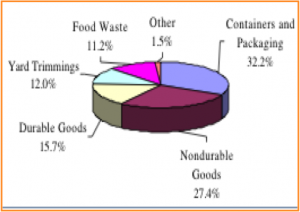Gas Emission
2000 EPA Municipal Waste Composition


Estimated Air Emission Rates for Selected Chemicals at the Fresh Kills Landfill
From The Agency for Toxic Substances and Disease Registry Report (1995 Study)
Emissions data are reported for the 20 chemicals (or pairs of chemicals) with the highest emission rates.
Notable Gas:
- Acetone: Exposure to acetone results mostly from breathing air, drinking water, or coming in contact with products or soil that contain acetone. Exposure to moderate-to-high amounts of acetone can irritate your eyes and respiratory system, and make you dizzy. Very high exposure may cause you to lose consciousness.
- Hydrogen Sulfide: Just a few breaths of air containing high levels of hydrogen sulfide gas can cause death. Lower, longer-term exposure can cause eye irritation, headache, and fatigue.
- p-Dichlorobenzene: Repeated exposure to p-dichlorobenzene may induce anorexia, weight loss, and liver and kidney damage. Four cases of blood dyscrasias, including leukemia, have been attributed to exposure, either alone or with other substances. A single case of allergic purpura thought to have been caused by exposure has been reported.
- Toluene: Toluene is a central nervous system depressant and an irritant of the eyes, mucous membranes, and skin in humans. In contact with the eyes, toluene causes reversible corneal injury; prolonged skin contact causes defatting and dermatitis.
- Xylene: Chronic exposure to xylene may cause central nervous system depression, anemia, mucosal hemorrhage, bone marrow hyperplasia, liver enlargement, liver necrosis, and nephrosis.
- 1997: 2,650 Tons of methane gas was released daily — which is 5.7% of all U.S. methane emissions and 1.8% of the world’s total methane production.
- See Barboza Graphs graphs and pictures for most recent estimates.
- Land Fill Gas Flow is estimated to decrease over time at 6,000-7,000 CFM ~2048 from 30,000CFM ~1997.
